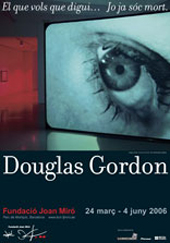- Dates
- —
One of the most remarkable features of present day artistic creation is the wide field of action open to artists. There are no limitations on either media or subject matter. What counts are ideas and the way in which they are expressed.
Douglas Gordon, who although relatively young has a long career behind him and has won such prestigious awards as the Turner Prize and the Hugo Boss Prize, is an example of an artist who makes use of the media of his time such as film, video, etc. But, however popular or populist these resources may be, in Gordon's hands they take on a quality that goes beyond aesthetics and places the results in a category where what matters are concepts and ideas. In this process it is the viewer who plays a fundamental role by becoming an accomplice in the work.
The images that Gordon uses, taken from films made either by himself or by others, serve to create situations that cause surprise, arouse emotions or simply make us think.
Alongside images from the cinema – considered throughout the twentieth century to be the youngest of the arts – Gordon also uses the system of communication that has its origins in the mists of time and that marks man out as a superior being: language.
His texts are unconventional: they astonish and disturb us, awaken our curiosity and, above all, make us realise that things are not always what they appear to be. On the contrary, every truth tends to conceal another truth. It is this invisible truth that interests Gordon and is the source of his predilection for contrasting concepts: fact and fiction, good and evil, truth and falsehood, life and death.


